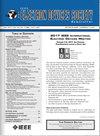Defects Passivation and Performance Enhancement of AlGaN/GaN HEMTs by Supercritical Hydrogen Treatment
IF 2.4
3区 工程技术
Q3 ENGINEERING, ELECTRICAL & ELECTRONIC
引用次数: 0
Abstract
In this paper, supercritical hydrogen treatment is used to passivate the defects of normally-on type AlGaN/GaN high electron mobility transistors. By comparing the electrical characteristics of devices before and after the experiment, the treated devices have shown larger on-state current, a negative shift of threshold voltage and shorter gate-lag. In addition, the reliability of the devices before and after treatment is tested by applying a DC reverse bias stress to the gate and the result indicates that the treated devices show less degradation after RB stress. At the same time, through the low-frequency noise test, it is further verified that the defect density near the 2DEG channel reduced from超临界氢处理AlGaN/GaN hemt的缺陷钝化及性能增强
本文采用超临界氢处理方法钝化了常导型AlGaN/GaN高电子迁移率晶体管的缺陷。通过对比实验前后器件的电特性,处理后的器件具有较大的导通电流、阈值电压负移和较短的门滞后。此外,通过对栅极施加直流反向偏置应力来测试处理前后器件的可靠性,结果表明处理后的器件在RB应力后的退化较小。同时,通过低频噪声测试,进一步验证了2DEG通道附近缺陷密度由$1.25 \倍10^{18}~ {\ mathm {cm}}^{-3}{\ mathm {eV}}^{-1}$降至$8.94 \倍10^{18}~ {\ mathm {cm}}^{-3}{\ mathm {eV}}^{-1}$。基于上述结果,提出了一个物理模型来证明钝化机理。原始钝化层和AlGaN势垒层存在许多悬空键缺陷,这些缺陷可以捕获电子并产生虚门效应。超临界氢渗透到材料基体中,使悬垂键钝化。本实验结果为提高AlGaN/GaN hemt可靠性的研究提供了重要参考。
本文章由计算机程序翻译,如有差异,请以英文原文为准。
求助全文
约1分钟内获得全文
求助全文
来源期刊

IEEE Journal of the Electron Devices Society
Biochemistry, Genetics and Molecular Biology-Biotechnology
CiteScore
5.20
自引率
4.30%
发文量
124
审稿时长
9 weeks
期刊介绍:
The IEEE Journal of the Electron Devices Society (J-EDS) is an open-access, fully electronic scientific journal publishing papers ranging from fundamental to applied research that are scientifically rigorous and relevant to electron devices. The J-EDS publishes original and significant contributions relating to the theory, modelling, design, performance, and reliability of electron and ion integrated circuit devices and interconnects, involving insulators, metals, organic materials, micro-plasmas, semiconductors, quantum-effect structures, vacuum devices, and emerging materials with applications in bioelectronics, biomedical electronics, computation, communications, displays, microelectromechanics, imaging, micro-actuators, nanodevices, optoelectronics, photovoltaics, power IC''s, and micro-sensors. Tutorial and review papers on these subjects are, also, published. And, occasionally special issues with a collection of papers on particular areas in more depth and breadth are, also, published. J-EDS publishes all papers that are judged to be technically valid and original.
 求助内容:
求助内容: 应助结果提醒方式:
应助结果提醒方式:


